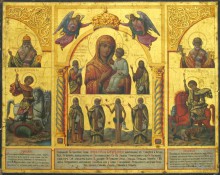The exhibition hall of the Kyivan Cave Monastery’s Assumption Cathedral is displaying lists of miracle-working icons of the Holy Virgin with gift inscriptions, 16th-18th-century wood-carved crosses and little icons, ancient printed books, and other unique items until April 20. Christians all over the world have honored Mount Athos for centuries as a “lot” of the Holy Virgin: the Mother of God showed this town’s pagans the way to the true faith and prayed to Christ that He leave this place under her patronage: “The grace of God be bestowed on this place and those who reside in it with faith and awe in the testaments of My Son.” What is worthy of respect is reverential attitude of Athos masters to the very process of icon painting: to make the holy image a real window to the divine world, the icon-painting monks showed great humility of mind, passionately prayed, and observed a long fast.
Olena LOPUKHINA, a senior research associate at the Kyivan Cave Preserve’s department of art heritage studies, says about the most precious exhibits: “The Ukraine-Athos links still remain. An illustrative example is two lists of Athos miracle-working images – the Mother of God ‘Quick to Hearken’ – painted on Mount Athos in 2013 and gifted by Docheiariou monastery monks to the Kyivan Cave Monastery. Almost all the Athos icons have a stenciled inscription of blessing on the reverse side, which includes the place of painting (Athos), the name of the temple, the name of the one to whom this holy icon was gifted, and the year of painting. The earthly “lot” of the Holy Virgin is represented in a large number of miracle-working icons, the Iviron Mother of God being the best known of them. Legend has it that this icon drifted by sea to the Holy Mountain in the 10th century during iconoclastic persecutions. The image of Mary the Redeemer is a replica, on the reverse of which it is written that hermit monks sent it as a gift to members of the Lviv Stauropegic Fraternity of the Assumption Church on May 13, 1905.

MARY THE REDEEMER (FROM PRESERVE’S COLLECTION)
The interesting items were made in the woodcarving technique – we can see at the exhibit the beneficial crosses and icons that carry a blessing from the Holy Mountain. The exhibit also displays some icons made at the St. Andrew’s Skete workshop. This skete was organized with support from Andrii Muraviov, a well-known Kyiv-based figure, the author of books on pilgrimage to Mount Athos. The icon of the Mother of God “In Sorrows Is Consolation” was gifted to Platon, the Metropolitan and Archimandrite of the Kyivan Cave Monastery. This icon was made in the Byzantine manner in the technique of tempera. The Little Russian Prophet Elijah skete is represented by a copy of the Holy Virgin’s icon “St. Mary the Feeder.” The skete’s founder Paisii Velychkovsky was born in Poltava and arrived at Mount Athos in 1750. Before that, he studied the art of engraving at the Cave Monastery. He revived the traditions of hesychasm and clerical eldership, maintained close ties with the Zaporizhian Sich, while the Kish Otaman Petro Kalnyshevsky was the benefactor of Ukrainian Athos pilgrims.
Olena Shapiro is an art historian







